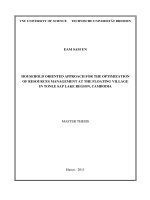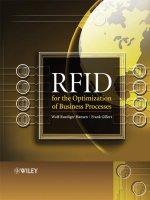Wiley RFID for the optimization of business processes apr 2008 ISBN 0470724226 pdf
Bạn đang xem bản rút gọn của tài liệu. Xem và tải ngay bản đầy đủ của tài liệu tại đây (3.18 MB, 301 trang )
RFID for the Optimization
of Business Processes
RFID for the Optimization
of Business Processes
Wolf-Ruediger Hansen
AIM Global, Germany
Frank Gillert
UbiConsult, Germany
Translated by
Kenneth Cox
Kenneth Cox Technical Translations,
Wassenaar, the Netherlands
With a contribution from
Viola Schmid
Darmstadt University of Technology, Germany
First published under the title RFID fur
¨ die Optimierung von Gesch¨aftsprozessen by Carl Hanser Verlag
Carl Hanser Verlag GmbH & Co. KG, Munich/FRG, 2006
All Rights reserved.
Authorized translation from the 4th edition in the original German language published by Carl Hanser
Verlag GmbH & Co. KG, Munich/FRG.
Copyright 2008
John Wiley & Sons Ltd, The Atrium, Southern Gate, Chichester,
West Sussex PO19 8SQ, England
Telephone (+44) 1243 779777
Email (for orders and customer service enquiries):
Visit our Home Page on www.wiley.com
All Rights Reserved. No part of this publication may be reproduced, stored in a retrieval system or
transmitted in any form or by any means, electronic, mechanical, photocopying, recording, scanning or
otherwise, except under the terms of the Copyright, Designs and Patents Act 1988 or under the terms of
a licence issued by the Copyright Licensing Agency Ltd, 90 Tottenham Court Road, London W1T 4LP,
UK, without the permission in writing of the Publisher. Requests to the Publisher should be addressed to
the Permissions Department, John Wiley & Sons Ltd, The Atrium, Southern Gate, Chichester, West
Sussex PO19 8SQ, England, or emailed to , or faxed to (+44) 1243 770620.
Designations used by companies to distinguish their products are often claimed as trademarks. All
brand names and product names used in this book are trade names, service marks, trademarks or
registered trademarks of their respective owners. The Publisher is not associated with any product or
vendor mentioned in this book.
This publication is designed to provide accurate and authoritative information in regard to the subject
matter covered. It is sold on the understanding that the Publisher is not engaged in rendering
professional services. If professional advice or other expert assistance is required, the services of a
competent professional should be sought.
Other Wiley Editorial Offices
John Wiley & Sons Inc., 111 River Street, Hoboken, NJ 07030, USA
Jossey-Bass, 989 Market Street, San Francisco, CA 94103-1741, USA
Wiley-VCH Verlag GmbH, Boschstr. 12, D-69469 Weinheim, Germany
John Wiley & Sons Australia Ltd, 42 McDougall Street, Milton, Queensland 4064, Australia
John Wiley & Sons (Asia) Pte Ltd, 2 Clementi Loop #02-01, Jin Xing Distripark, Singapore 129809
John Wiley & Sons Canada Ltd, 6045 Freemont Blvd, Mississauga, ONT, L5R 4J3
Wiley also publishes its books in a variety of electronic formats. Some content that appears in print may
not be available in electronic books.
British Library Cataloguing in Publication Data
A catalogue record for this book is available from the British Library
ISBN 978-0-470-72422-4
Typeset in 10/12pt Optima by Laserwords Private Limited, Chennai, India
Printed and bound in Great Britain by TJ International, Padstow, Cornwall
This book is printed on acid-free paper responsibly manufactured from sustainable forestry in which at
least two trees are planted for each one used for paper production.
To Ute and Marita
Contents
Contributor
Foreword
Preface
2 Vision, Reality and Market Drivers
Process Drivers
Security as a Driver
Mandates, Mentors and Sponsors
Technology Drivers
3 The RFID Market
3.1
3.2
3.3
The RFID Value Chain
Trends in the RFID Market
Application-Specific Trends in the RFID Market
4 Business Process Structures
4.1
4.2
4.3
4.4
4.5
4.6
xiii
xv
1 Introduction
2.1
2.2
2.3
2.4
xi
Evolution from Supply Chain to Supply Net
Strategies for Supply Chain Integration
Business Processes in the Retail and
Consumer Goods Industry
Business Processes in the Packaging Industry
Business Processes for Container Systems and
Returnable Transport Item Systems
Economic Viability Analysis Methods
1
9
18
23
28
33
37
37
41
44
49
50
56
60
68
77
84
viii
CONTENTS
5 Virtual Identities
5.1
5.2
5.3
5.4
95
Object Websites
The EPCglobal Network
RFID Standards
GS1 EANCOM EDI Standard
95
98
102
117
6 IT Architectures and Services
121
6.1
6.2
6.3
RFID and Higher-Level IT Architectures
Software Agents
Real-Time Enterprise Infrastructure
7 Auto-ID/RFID Infrastructure
7.1
7.2
7.3
7.4
7.5
RFID Tags
RFID Readers and Antennas
Near-Field Technology (NFC)
Prerequisites for RFID Infrastructure Implementation
Global Positioning with GPS/GPRS
8 Consumer Protection and Data Protection
in RFID Applications
8.1
8.2
8.3
8.4
8.5
RFID and Data Protection
General Data Protection Aspects
Data Protection Legislation Aspects of Scenario 1
Data Protection Legislation Aspects of Scenario 2
Data Protection Legislation Aspects of Scenario 3
9 RFID Legislation in a Global Perspective
9.1
9.2
9.3
9.4
9.5
RFID Scenarios
Fair Information Practices for Personal Data:
Traditional Law
Fair Information Practices for RFID Data
RFID Law
RFID and Law: A Summary of the Situation in 2007
10 Applications
10.1
10.2
10.3
10.4
10.5
10.6
10.7
10.8
10.9
Logistics Processes at Hewlett-Packard
Mobile Maintenance at Fraport
Locating Cars at Dat Autohus
Locating Persons in Hazard Areas
Electronic Ticketing in Public Transport Systems
Application Scenarios for NFC Mobile Telephones
Monitoring Components in Computer Centres
Aircraft Seat Quick-Change at Lufthansa
Trolley Asset Management at the Finnish Post Office
121
137
151
163
163
169
176
178
191
197
197
199
200
200
204
209
209
211
212
214
218
221
221
223
225
229
231
234
236
240
243
CONTENTS
10.10 Tracking Containers and Products at KPN
in the Netherlands
10.11 RFID Optimizes Garment Logistics at Gardeur
10.12 Agent Technology in Intralogistics Systems
11 Appendix
11.1
11.2
11.3
Index
References
Information Sources on the Internet
Glossary
ix
245
249
253
257
257
264
267
275
Contributor
Professor Viola Schmid PhD, LLM (Harvard) assumed the Chair of
Public (International) Law in the Faculty of Law and Economics of the
Darmstadt University of Technology (Darmstadt, Germany) in 2002.
Her research areas are cyberlaw, e-justice and freedom of speech.
Contact:
Foreword
Radio frequency identification (RFID) is used in countless areas where
there is a need for wireless identification of objects and transmission of
data. RFID devices can take the form of wireless tags attached to products,
cases or pallets, or they can be implemented in smart cards or telephones
with smart card attributes carried by ordinary citizens. It is foreseeable
that RFID technology will spread over the entire world. Companies in
the USA and Asia are committed to rapid introduction of this technology,
while Europe is still hesitating.
Naturally, we must not ignore the privacy risks associated with using
RFID technology, to the extent that data carried by or associated with
wireless tags can be used to deduce the behaviour of citizens or obtain
information about them. There are still many unresolved issues here,
which also relate to legal aspects. European legislators have not yet
arrived at a definitive position on the use of RFID technology. For this
reason, the European Parliament launched an initiative on the theme of
RFID in early 2006, under the umbrella of the Scientific and Technological
Options Assessment (STOA) programme.
Viviane Reding, European Commissioner for Information Society and
Media, opened the debate on 9 March 2006 at the CeBIT fair in Hanover.
With this, she highlighted the importance of RFID, including its significance for the Metro Future Store Initiative. Commissioner Reding was
feeling her way toward a concrete, written legislative initiative by conducting expert hearings. In May and June 2006, Key Theme workshops
for this purpose were held in Brussels under the direction of the EU,
with numerous experts among the participants. In March 2007 at the
CeBIT again, Reding presented a Communication addressing major RFID
issues. In June 2007, the Commission organized a conference in Berlin
titled ‘Toward the Internet of Things’, which was widely regarded as very
successful.
The aim of the STOA activities initiated by the European Parliament
is to discuss a visionary approach and develop future scenarios that
xiv
FOREWORD
reflect the perspectives of industry, suppliers of technologies and services,
and consumers. This is intended to give the members of the European
Parliament and decision-making bodies at the European level a clear
understanding of how they can help foster European interests in RFID
technology and secure market opportunities for Europe while at the same
time protecting citizens against abuse of this technology. In early 2007,
STOA presented a complete study on the anticipated consequences of
RFID technology. This study is available on the STOA website.
In parallel with this, measures for Research Programme 7 (RP7) must
be developed to provide successful incentives for research and industrial
development on the way to creating the ‘internet of things’.
I am pleased to see that this book addresses not only the technical
aspects of RFID technology, but also the application aspects – in other
words, the technology as seen from the perspective of industrial, logistical
and consumer-related processes that can be enhanced with RFID. This
helps keep the debate objective, and the many application scenarios show
that RFID technology is already used much more extensively than most
laypersons realize. This book thus comes at the right time to underpin the
European discussion and clarify the technology for future users.
I hope that a large number of people read this book, and I expect that
it will give the debate an objective point of reference.
Jorgo Chatzimarkakis,
Member of the European Parliament
Brussels
Preface
This book is aimed at two groups: organization specialists and people who
are responsible for optimizing business processes. We wish to assist them
in developing concepts for improving business processes that are intended
to be implemented using IT systems and radio frequency identification
(RFID) systems. We also describe the main features of the underlying
technical infrastructure of RFID technology in order to give organizers an
overview. Nevertheless, we recommend that technology experts consult
more detailed literature, such as the proven RFID Handbook by Klaus
Finkenzeller, which is also published by John Wiley & Sons.
Our primary objective is to forge a link between the technology and
the application scenarios for using the technology to support business
processes in business and industrial environments. Here we believe that
it is especially important to show that the benefits of RFID methods are
not limited to the latest generation of RFID tags, but instead result largely
from their potential uses in processes, in particular logistics processes.
The task facing potential users is thus to determine the potential benefits
of using RFID technology in their enterprises, or better yet do this in
cooperation with their business partners, in order to compare them
with the associated costs of the envisioned solution (and in this order).
RFID technology applications often fail due to lack of agreement on
how to allocate the costs and benefits of processes that span enterprise
boundaries. We devote considerable attention to the business processes
concerned in order to help overcome this hurdle.
The public debate on RFID technology is presently focused too much
on the details. For instance, some people claim that the only thing
necessary for the commercial success of RFID tags is a sufficiently low
price. Others hope that all that is necessary is to refine the antennas of
RFID tags sufficiently to obtain the required reading properties. These
discussions focus too much on individual technical aspects and fail to
see the overall picture. Improving the edgeware, which consists of the
xvi
PREFACE
software components that control the readers, is also only one part of the
overall picture.
By now, tags with unit prices of less than 10 eurocents have been
announced, but there is still no explosion in use of RFID technology.
Why not? Because the next step on the way to the global use scenario still
has to be taken: installing a broad base of RFID readers and integrating
them into enterprise resource planning (ERP) systems, which run on corporate servers and perform core business management tasks. In parallel
with this, communication systems must be extended along the logistics
chains of the enterprises concerned. Tag prices are only a small part of
the overall picture.
Current market trends also show that there will not be any single,
common RFID technology for all application scenarios, because the
physical laws that govern the behaviour of radio signals create a variety
of obstacles. These obstacles can only be overcome by using a variety
of RFID technologies. Here we particularly have in mind the capabilities
and limitations of the various frequency bands. RFID systems can operate
in selected frequency bands between 125 kHz and 5 GHz. Although
the efforts of industry consortium EPCglobal to establish the UHF band
(860–960 MHz) as the only global standard in the trade sector may
have succeeded with regard to RFID tags for cases and pallets in trade
environments, the frequency of 13.56 MHz (HF band) will be more significant for wireless tags on individual articles. Reader manufacturers are
already developing reader antennas that can handle both frequencies.
EPCglobal has recognized this situation and announced that the Generation 2 standard, which up to now has been based on the UHF band, will
be extended to include the HF band.
In the European debate on RFID, we often have the impression that
market penetration has already progressed significantly further in the
USA than in Europe. In our view, this impression is false. Among other
things, it relates to the fact that the level of organization and extent of
IT penetration in logistics chains are lower in the USA than in Europe,
which means that the US situation offers significantly more room for
improvement by using RFID technology and other measures. As a result,
many RFID success stories in the USA can only partly be attributed to the
use of wireless tags, with general process improvements and increased
employee discipline also playing a significant role. This has been shown
by a recent study carried out at Wal-Mart [Hardgrave05].
The claim that barcodes are on the verge of being replaced by RFID,
which is made repeatedly in euphoric marketing statements, is actually counterproductive and false. Both technologies will persist in a
complementary relationship for many decades. It is thus the duty of
planners in organizations to comprehensively assess the benefits of all
auto-identification technologies and assign each technology the tasks for
PREFACE
xvii
which it is best suited. Helping them to do this is also one of the aims of
this book.
This book would not have been possible without the information and
assistance the authors received in conversations with numerous experts.
Our discussions with Professor Elgar Fleisch and Professor Friedmann
Mattern were especially valuable. Professor Fleisch is a director of the
Institute of Technology Management at the University of St Gallen (HSG)
in Switzerland and co-chair of the Auto-ID Labs (www.autoidlabs.org),
where he is working with a global network to develop and refine the
infrastructure of the ‘internet of things’. Professor Mattern lectures at ETH
Zurich
¨
and is head of the Distributed Systems Research Group of the
Department of Computer Science. The two professors jointly head M-Lab
(www.m-lab.ch).
The seed for this book was sown by the RFID White Paper published
in Berlin in 2005 by the RFID Project Group of the industry association BITKOM eV. The authors of this paper collaborated with experts
in major IT enterprises, including Cisco, GS1, Hewlett-Packard, IBM,
Infineon, Intel, SAP, Siemens and T-Systems. We are grateful to BITKOM
for permission to utilize their insights in this book. We also extend special
thanks to Dr Norbert Ephan of Kathrein-Werke KG in Rosenheim, Germany, who never tired of adapting our process-oriented requirements to
the engineering realities and physical circumstances that govern the use
of RFID tags, readers and antennas.
We also owe a special word of thanks to the EICAR RFID Task
Force, whose theme ‘RFID and data protection’ provides the basis for
Chapter 8. The chair of the task force, Robert Niedermeier, was kind
enough to proofread the original text and confirm his reputation for legal
correctness.
The German legislative perspective described in chapter 8 is enlarged
in chapter 9, which presents a global overview of RFID legislation in
various countries throughout the world. We owe special thanks to Professor Viola Schmid, Chair of Public (International) Law in the Faculty of
Law and Economics of the Technical University of Darmstadt, Germany,
who provided chapter 9 specifically for the English edition of our book.
This substantially increases the value of the book for an international
readership.
Furthermore, many thanks go to Peter Kreuzer, an automotive expert
of the VDA, who provided us with a deep insight into standardization in
the automotive industry and thus enabled us to include a section on this
market sector.
Finally, we are proud of two contributions from the academic world:
the description of agent technology in internal logistics systems
(Section 6.2 and the application case in Section 10.12) by Dirk
Liekenbrock of the Fraunhofer Institute for Material Flow and Logistics
xviii
PREFACE
in Dortmund, and the description of the requirements for implementation of RFID infrastructures (Section 7.4) by Jan Hustadt of the Logistics
Department of the University of Dortmund.
We would also like to thank the companies that enabled us to document the application cases described in Chapter 10. They show that
proliferation of RFID use occurs unobtrusively more often than openly,
and that it is worthwhile for process managers in enterprises to profit from
the experience of others by looking for existing solutions that can serve
as models and be adapted to their own needs.
Last but not least, we would like to express our appreciation for the
patient, trustworthy and constructive cooperation of Margarete Metzger
and Irene Weilhart at Carl Hanser Verlag and Simone Taylor at John
Wiley & Sons, and the translation by Kenneth Cox. They gave this book
its final and vital finishing touches.
Dr Frank Gillert and Wolf-Ruediger Hansen
Frankfurt/Munich
1
Introduction
Radio frequency identification (RFID) is a seemingly simple technique.
Data is stored in RFID tags that are attached to objects or located in
smart cards, and this data can be read using radio signals and presented on a display by using a suitable reader. The data can then be
transmitted automatically to an information technology (IT) system for
further processing. Although this method is easy to describe in technical
terms, there are many obstacles in the areas of application technology
and integration into operational processes that must be overcome before
it can be used operationally. For this reason, this book concentrates
primarily on the potential economic benefits that can be realized from
improvements to business processes that can be achieved using RFID,
rather than on the technical aspects of how RFID tags and readers work
and what they do. Our objective here is to examine RFID technology
as a whole in the context of enterprise processes and higher-level IT
systems.
There are essentially two groups that are interested in using RFID
technology. The first group consists of the innovators, the advocates of
new technology, who argue that it can create added value in the form
of short-term or long-term benefits. They incorporate RFID technology
in their strategic plans and start experimenting with it at an early stage.
Other enterprises, by contrast, find themselves forced to introduce RFID
because their customers demand it, for example due to the policy of
mandated requirements pursued by large retail groups. In addition, they
are afraid of losing ground to competitors and missing out on competitive
advantages. In terms of marketing theory, the first group is referred to
as the innovators, visionaries or early adopters, while the second group
is referred to as the ‘conservative majority’ or ‘laggards’. They are also
called the ‘fast’ and ‘slow’ groups [Moore96].
In this book, RFID is regarded as one of several auto-ID technologies
that can be used to identify objects or persons. It is not our intention here
RFID for the Optimization of Business Processes
2008 John Wiley & Sons, Ltd
Wolf-Ruediger Hansen and Frank Gillert
2
INTRODUCTION
to create the impression that RFID is always the ultimate solution. We are
convinced that barcodes still have a long life ahead of them and that they
will be used alongside RFID in a complementary fashion, particularly in
trade environments.
The debate on the potential success of RFID technology is not aided by
the fact that a global media hype has developed on the subject of RFID.
For one thing, this hype fosters fear of losing control over how personal
data is used and reduces willingness to accept new technologies. It also
encourages enthusiasts to devise unrealistic scenarios and lose sight of
circumstances that constrain the use of the technology, in particular
physical constraints. However, euphoric behaviour of this sort is often
seen when a new technology is introduced. A US marketing research
company, Gartner, has developed a model of the hype cycle in order
to describe this phenomenon. The RFID hype cycle is described in
Chapter 2, ‘Visions, Reality and Market Drivers’, which also shows that
there are many ways to put RFID technology to good use, even if some
approaches ultimately land in the ‘trough of disillusionment’ as often
happens with innovative technologies.
If you follow the public statements of the industry consortium EPCglobal and its members – e.g. retailers such as Wal-Mart and Metro – you
often get the impression that RFID is already in common use. However,
this is not so. Here it is important to recognize the correct context for
viewing the various aspects of RFID applications. Up to now, the key
significance of the RFID innovation project of the Metro Group lies less in
the actual implementation of RFID methods than in their comprehensive
portrayal of the capabilities that could be made available to retailers in
the medium to long term, not only in branch outlets but also along the
entire supply chain. With its commitment to RFID, the Metro Group has
created an internationally communicated image as an innovator. In the
view of the international market, this puts it at the same level as much
larger groups such as Wal-Mart in the USA. This should be regarded as an
aspect of corporate strategy, and in particular as a way to send a message
to the stock markets. Information about the status of the project and the
accumulated experience and insights gained from it are reported quite
extensively in Metro’s freely available RFID Newsletter, which appears
several times a year [Metro2603].
Another factor that blurs the issue, and which is an unintended result
of the extensive publicity efforts of the EPCglobal consortium, is the
fact that EPCglobal’s market activities are often regarded as generally
representative of all possible RFID solutions. They should instead be seen
in perspective, because there are many areas – such as production control
systems in manufacturing companies and smart card applications – that
lie outside the sphere of influence of EPCglobal. Anyone interested in
the subject is well advised to acquire a good understanding of the
various aspects and players in order to obtain a balanced view of the
INTRODUCTION
3
RFID situation. The applications described in Chapter 10 also provide a
suitably broad overview.
In the EPCglobal domain, which means in the retail sector and other
directly related sectors, practical implementation of RFID techniques is
proceeding much more slowly and with much more effort than what
can be seen at first glance. In the press and at trade fairs, attention is
often focused on individually tagged items. We see them being placed
in special shopping carts, which must be made from plastic so the
antennas will not be screened by the metal grids normally used for this
purpose. Then we see how the items are automatically identified at the
checkout and a receipt is generated ‘on the fly’. This scenario is still a
fantasy, as according to Metro’s own statements it will take at least five
years before comprehensive item tagging becomes generally established.
As an exception to the situation in the EPC world, clothing articles are
increasingly being tagged at the item level. In the retail sector, the primary
interest at present is on tagging pallets and cases, which addresses logistics
issues. Outside the retail sector, one example of an application where
RFID tags are already being used successfully is in identifying books. The
current process drivers for RFID technology are described in Chapter 2.
Chapters 2, 3 and 4 are largely devoted to logistics aspects, since this is
where the greatest potential benefits are expected to be found. However,
the situation is complicated by the fact that the potential benefits can
only be realized if the various enterprises in a particular supply chain
can agree on comprehensive solutions. Consequently, decision-makers in
these enterprises need more support with projects that involve using RFID
in logistics chains – which means planning ‘open’ systems – than with
projects that involve using RFID to support internal processes (‘closed’
systems), such as in production control environments.
One of our specific objectives in describing logistics aspects is to
help small and medium-sized enterprises (SMEs) understand the processspecific context so they can start participating in the RFID processes of
the major players in a timely fashion. For their part, the large retail groups
must include SMEs in the process if they want to see their RFID strategies
realized in the end. They will pursue this goal by using more or less gentle
persuasion (‘mandated requirements’). For players in the SME sector, it
is thus important to be prepared for the introduction of RFID in order
to avoid the risk of losing customers due to insufficient technological
adaptability.
The potential benefits that can be seen in the market are discussed in
detail in Chapter 3. There we describe the market structures, value chains
and foreseeable market consolidations in order to give users a better
understanding of why suppliers act in particular ways and the strategies
they develop to position themselves in the market.
Chapter 4 presents a highly detailed view of planning and process
structures, which above all will force supply relationships to change
4
INTRODUCTION
from the existing pattern of bilateral relationships between suppliers
and customers to a pattern of multilateral network relationships – the
‘supply net’. Using RFID technology is also expected to eliminate a
well-known shortcoming of the retail supply chain: the ‘bullwhip effect’.
This effect occurs because the volumes of merchandise sold in branch
outlets and held in intermediate stocks or by suppliers are systematically
overestimated or underestimated. In the first case, this generates excessive
stock levels, which tie up significant capital and always lead to asset
losses, for example when goods can no longer be sold because they
have become outdated in stock. In the second case, it results in stock
shortages that lead to empty shelves (out-of-stock items). The net result
is a combination of avoidable costs and lost revenue, which can easily
consume an already narrow profit margin.
We also discuss planning and process structures that can be supported
especially effectively by RFID methods and can be utilized either incompletely or not at all in the absence of RFID, such as vendor-managed
inventory (VMI), efficient consumer response (ECR), and collaborative
planning, forecasting and replenishment (CPFR). As can be seen from this
discussion, enterprises that cannot agree with their trading partners on
transparent management of supply chains are also not sufficiently mature
to use RFID technology. Based on these general approaches, we then
examine the potential benefits in more detail. We discuss suppliers in the
packaging industry and service provider structures. This is followed by an
in-depth look, at the subprocess level, of analytical models for assessing
economic viability.
Data processing in IT systems always involves identifying the objects for
which the data is to be processed. Introducing RFID leads to serialization
of the objects, which means that individual objects can be identified
uniquely. The barcodes presently used in merchandise systems only allow
the product type to be identified. A barcode consists of a manufacturer
number (producer) and a product number (object type). Schemes such as
the Electronic Product Code (EPC) can be introduced with RFID systems.
This code includes a serial number in addition to the other data. This
makes it possible to distinguish one bottle of apple juice from another
one next to it – every bottle has a virtual identity. The EPC strategy is the
focus of Chapter 5.
In the case of apple juice, it might reasonably be asked whether
this serialization is worth the effort. However, it becomes a lot more
sensible if you consider medicine packaging. Besides the logistics benefits,
one of the objectives here is to protect products against counterfeiting,
and particularly in the pharmaceutical sector to maintain pedigrees
(e-pedigrees) that describe a product’s history from production through
the entire retail supply chain to the consumer. Here pharmaceutical
products must be handled in the same way as technical replacement
parts for cars or aircraft. Pedigrees also allow recall campaigns to be









